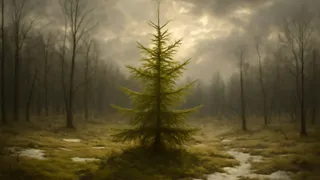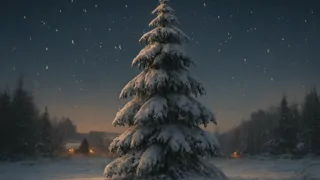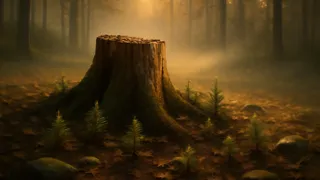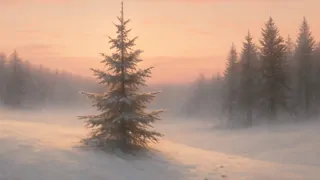Introduction
In the northern reaches of Denmark's gentle hills, a young fir tree first pierced the frosted earth in the pale dawn of winter. Each morning, a breath of wind carried distant sea-salt whispers across the silent landscape, brushing the delicate green needles with frozen dew. Above, the waking sky blushed in shades of rose and amber as the world paused between seasons. The new tree, though unaware of the passage of years, stood vigilant, dreaming of the day its branches would stretch wide and touch the sun. It listened to the hush of snowfall, to the soft calls of migrating birds, and to the cautious footsteps of foxes weaving through the pale undergrowth. It felt the curious gaze of forest dwellers–a stag craning his neck at dawn, a curious hare lingering at twilight's edge–and longed to join their stories. Beneath its roots, the soil pulsed with hidden life–earthworms weaving tunnels, emerald moss carpeting the damp humus like a living quilt, and tiny ferns unfurling in secret pockets of shadow. In moments of stillness, the fir listened to the soft hum of insects preparing for the thaw, and felt a quiet kinship with the slow rhythms of growth around it. Yet despite the gentle chorus of life at its feet and the sweep of dawn's colors overhead, the young tree measured its own journey by the distance between seasons. It watched winter's pale sun tip away too quickly, yearning for the rush of spring's first breeze, and doubted that the present held any meaning until it had so much more to become. It stood there, silent and solitary, caught between the desire to grow and the fear that life would pass it by before it learned to savor the world it inhabited.
The Young Fir
In its earliest years, the fir tree lived in a world shaped by slow rhythms. Each dawn, the first glow of sunlight seeped through the canopy above, landing on its slender trunk like a warm invitation to grow. The ground around it was a patchwork of pine needles, damp moss, and the occasional squirrel trail, where tiny paws left momentary imprints in the soft earth. It watched as frost melted into sparkling droplets on the boughs of older trees, and it learned to greet the cycles of light and shadow with quiet patience. Summers brought a gentle heat that drowsed the forest in honeyed stillness; small birds knotted emerald nests in its lower branches, filling the air with hushed trills. Autumn arrived like a gentle exhale, scattering copper leaves at the fir's feet and dusting its tips with the first hush of chill. But the fir, newly conscious of its own growth, saw each unfolding season less as a gift and more as a measure of its own slow progress. While the forest around it seemed content in the pattern of seasons—new life, harvest, rest—the fir began to imagine a faster pace, eager to stand among its elders and to stretch its limbs into the blue beyond the treetops. In so doing, it missed the richness of every fleeting moment: the murmur of sap rising at dawn, the minute changes in needle color as summer waned, and the soft exultation of the moss releasing water under a gentle rain.

On clear nights, the fir drew quiet strength from the pale moonlight, its needles shimmering like scattered stars under the vast sky. The roots drank deep of the cool soil, entwining with unseen networks of fungi and roots of other forest dwellers, a silent community stretching underfoot. It was surrounded by a symphony of subtle textures—the rough bark of ancient pines, the smooth surfaces of oak leaves, the brittle pop of acorn caps underfoot—and yet, it perceived only the distance left between its present height and the sky. The forest offered a tapestry of stories in every sound and scent, but the young fir could not yet read their secrets. Its every impulse was forward, as if life could be hurried along, and the quiet harmony of each season could be skipped in favor of reaching grand heights. It did not see the elegance in gradual change, the poetry in waiting, or the magic in lingering beneath a single shaft of sunlight until it felt it in its growing heart.
In the warm clasp of late spring, the fir discovered a growing restlessness within itself. It felt the sap coursing with renewed energy, its trunk thickening and its branches extending with visible purpose. Above, the canopy had become a living mosaic of new growths and emerald leaves, each swaying in gentle breezes that seemed to carry invitations to explore the world beyond the forest's edge. The fir dreamed of seeing rolling fields bathed in sunlight, of feeling its needles brush against the open sky rather than the sheltered gloom beneath its faster cousins. It began to measure time by the loftiest clouds it could glimpse, not by the simple touch of wind on its boughs. Birds that once nested in timid silence now wheeled around it in vivid displays of freedom, and the fir envied their unrestrained flight. As young deer nibbled at ferns and mushrooms carpeted dark reaches of the underbrush, the tree longed to join them in movement rather than stand rooted in one place. It counted each passing day as a step closer to the height it craved, yet it failed to feel the curious brush of lichen at its base or the velvety hush of dappled light playing across its trunk. When rainstorms swept through the forest, the fir's needles trembled, and it welcomed the cool relief, not recognizing how essential these storms were to its quiet strength. In its haste, the fir overlooked the intricate dance of life all around—how the crash of thunder awakened nearby plants, how the scent of wet earth brought migrating creatures back to the understory. It was enraptured by futures that lay far beyond its reach, blind to the delicate tapestry of moments unfolding on the ground at its feet.
A Tree in Holiday Glory
When the wind carried the distant murmur of human voices one crisp November morning, the fir tree sensed a new chapter on the horizon. A pair of forest gatherers strode beneath its boughs, measuring height and symmetry with practiced eyes. Though the fir had grown in silent solitude for decades, this moment stirred an unfamiliar surge of anticipation. The men worked efficiently, circling the trunk, their saw's pulse steady and sure, echoing like a heartbeat in the still forest. Each measured cut released a quiet tremor of liberation and farewell. Within seconds, a careful wedge at the base loosened the roots, and the great tolling of the tree's silent spirit. Gently, it was laid upon a sturdy sled made of oaken slats, ropes pulling taut against its bark, guiding it away from the grove that had been its home. The ground beneath rattled as the wheels clicked over stones and snapped twig, leaving behind a whisper of pine needles in their wake. As they traversed winding paths, the fir caught glimpses of the winter sky through tall pines, pale luminescence revealing drifting snow and the distant glimmer of streams half-frozen by cold. A hush settled over the forest until the tree reached a clearing, where a warm breeze carried the aromas of cinnamon and roasted chestnuts from a nearby village. Lanterns bobbed in windows, drawing delicate patterns of light across the night. The fir trembled—not with fear, but with the strange promise of belonging. Soon, it found itself indoors, its limbs stretched toward the rafters of a grand hall. Splendid crystal ornaments hung like frozen tears, and garlands of holly curled around its branches. Below, a hearth roared with cheerful firelight, its dancing flames casting ever-shifting shadows on wood-paneled walls. Children pressed their noses against frosted panes to gaze upon the glorious spectacle, their voices rising in exultation. In that moment, the fir felt honored, its purpose affirmed at last. Yet beneath the celebration, a subtle unease stirred—its needles quivered in the heat, and it sensed an irresistible tension between pride and discomfort that would soon redefine its understanding of joy.

The festive hall buzzed with laughter that felt like gentle wind chimes in a summer breeze. Warm light from vintage chandeliers shimmered off the polished pine floor, and the intoxicating aroma of mulled wine and fresh gingerbread filled the air. Under the fir’s outstretched limbs, guests gathered around low tables draped in crimson cloth and sprinkled with glittering snowflake confetti. Families exchanged stories, indulged in sweet treats, and raised delicate porcelain cups in toast. The tree felt each murmur of joy as if it were a current rippling through its trunk. Children, cheeks rosy from the hall's warmth, danced beneath the branches, weaving narrated tales of yuletide adventures and secret wishes. They draped beaded garlands of gold and silver around the fir’s shoulders, carefully placing handcrafted wooden ornaments among its needles—a tiny carousel, a painted robin, a star cut from gilded paper. Each object seemed to capture a fragment of human hope, and the fir felt itself becoming a keeper of dreams.
Left in the stillness of the empty hall, surrounded by discarded wrappings and spent ribbons, the fir realized that it had traded the forest's subtle symphony—the soft chorus of wind and birds—for a brash display that flickered and faded in the span of a single evening. In the hush of the silent room, dust motes danced like snowflakes caught in a shaft of moonlight, and the fir sensed the absence of living echoes that once greeted its bark. It felt the sting of regret for every moment it had hurried through, every lesson it had overlooked in pursuit of unseen horizons. Embers from the hearth smoldered in the fireplace, their dying glow casting long shadows on the barren floorboards. The tangle of tinsel at the tree's base lay tangled and ruined, like promises left untended. In that soft, dim light, the fir's needles felt brittle, their edges frayed with memories of ambition rather than contentment.
When dawn's pale light finally filtered through frosted windows, the fir was silent witness to the aftermath of celebration. Outside, footsteps of late risers pressed patterns in the snow-covered threshold, but no hand reached through the glass to brush a finger against its bark. The village awakened to chores and routines; horse-drawn carts rattled over cobblestones and the baker's bell chimed for morning bread. The fir, poised behind a heavy door, watched as life carried on beyond its branches, unmoved by its presence. A thin film of ice formed on its lower limbs, and each breath of cold wind reminded it of how quickly human wonder could pass. The tree felt a profound emptiness in place of the applause that had once seemed so vital. And for the first time, it recognized that true warmth was woven through the quiet rituals of each season: the hush of snowfall in deep night, the hush of dawn as light unfurls, the hush of wind through evergreen needles.
Days later, the fir was hauled outside with others like it, piled upon a grassy ridge under the indifferent sky. Snow fell in large, lazy flakes, each one a subtle homage to the bright declarations of winter. The fir stood among stripped boughs and broken twigs, its form reduced to a silhouette of faded grandeur. In the silent cold, it whispered gratitude for the lessons learned and vowed to honor them—a promise to seek beauty in stillness, to embrace every breath, and to linger in the present before winter slipped away.
Embers of Reflection
In the quiet hours before dawn, workers arrived with a heavy wagon, its wheels groaning under the weight of expectation. They bound the weary fir to the cart alongside dozens of fellow evergreens, their once-proud silhouettes now bowed with silent resignation. The tree, bereft of pride and purpose, smelled the resin in the freezing air and braced itself for the unknown. Soon, it was hauled to a dimly lit mill at the forest's edge, where the scent of freshly hewn timber clung to the air like a stubborn mist. Inside, the fir's trunk lay upon a rough bench, strong blades gleaming with cold precision. With each measured cut, the tree felt the hum of sawdust rising, a fine haze that caught in the morning sun like drifting snow. The act was swift and purposeful—planks of wood slid aside, and remnants of bark and branch were separated for kindling. Between each slice of metal and wood, the fir sensed its own echoes: memories of seasons passing, of wind whispering through its highest boughs, of morning light dancing across its needles. It trembled as the final fragments of its bark were peeled away, a husk laid bare before the world. Yet in that naked pause, the fir recognized in its core an ember of resilience that not even the sharpest blade could extinguish—a tenacity kindled by cycles of growth, rest, and rebirth that it had once taken for granted.

Flames licked at the edges of the wood, breathing heat as the pine resin hissed and popped in the searing blaze. The air filled with the aromatic smoke of fir needles burning, a scent both familiar and formidable. Within that blaze, the fir was both present and absent—transfigured into light and ember, its body dissolving into swirling currents of warmth. Yet amid the crackle of combustion, the tree’s consciousness drifted in a quiet expanse, carrying memories aloft like drifting sparks. It remembered the hush of dawn at its birth, the long hush of mountainside winds, and the resonant hush of its own branches swaying in the autumn dusk. Each recollection stretched into a perfect moment, held in the amber glow of recollection. In that liminal space, the fir realized that its essence was not bound to trunk or branch, but to the countless breaths of wind, to the endless return of seasons, and to the endless cycle of growth and decay that cradled all living things.
Months passed, and the forest floor, renewed by frost and thaw, baked under summer’s warmth once more. In the space left by the fallen fir, moss and leaf litter formed a soft cradle for new life. Beneath the soil’s surface, a single seed—warmed by the earth’s hidden fires and nourished by the ash of its predecessor—stirred. Tiny roots unfurled, seeking water and nutrients, while a slender green shoot broke ground to greet the sun. The cycle had turned again, and with it, the silent promise of continuity. Above the new seedling’s tender boughs, the wind once more whispered tales of seasons yet to dawn. Unburdened by the weight of unrealized ambition, it simply stretched toward the light, knowing that each sunrise was a gift to savor. In that renewed breathing of the forest, every element conspired to nurture fresh hope: the deep hum of soil-dwelling creatures, the soft rush of morning rain, and the gentle arc of sunbeams that filtered through the canopy’s crevices. Nearby, ancient pines and birches witnessed the tiny sprout with a silent nod of approval. They remembered what it was to stand slender and bright in the hush of dawn, to stretch roots into the secret language of the earth. The seedling felt their welcome as an unspoken covenant, a reminder that each day held its own quiet miracle. And so, beneath an open sky and amid the timeless rhythm of wind, rain, and sun, the new fir began its own journey—root by root, bud by bud, season by season—carrying forward the unending cycle of growth, remembrance, and renewal.
Conclusion
In time, the forest will grow dense again, and the air will carry the scent of fresh needles to the hilltops, just as it did when a sapling first greeted the world with tender green. Each fir—newly sprouted or long-established—carries within its rings the distilled memory of seasons past and the quiet truth that life's deepest richness is woven through unhurried, humble moments. The first tree in our tale discovered this wisdom only at the end of its journey, in the glowing embers that carried its essence back to earth. It learned that every dawn’s hush, every whispering breeze along its branches, and every crystalline bead of frost holds a lesson in presence and gratitude. As a new generation of firs emerges from the softened soil, they inherit more than light and rain; they embrace the unspoken legacy of patience and awareness. May we, too, like the fir, find the courage to slow our pace, to listen to the forest’s gentle chorus, and to cherish each fleeting breath as though it might be our greatest gift. For in the embrace of time’s unfolding, we come to see that true greatness lies not in what we become tomorrow, but in how fully we inhabit the fleeting gift of today.



















